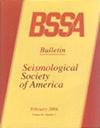Achieving a Comprehensive Microseismicity Catalog through a Deep-Learning-Based Workflow: Applications in the Central Ecuadorian Subduction Zone
IF 2.9
3区 地球科学
Q2 GEOCHEMISTRY & GEOPHYSICS
引用次数: 0
Abstract
Although seismological networks have densified along the Ecuadorian active margin since 2010, visual phase reading, ensuring high arrival times quality, is more and more time-consuming and becomes impossible to handle for the very large amount of recorded seismic traces, even when preprocessed with a detector. In this article, we calibrate a deep-learning-based automatized workflow to acquire accurate phase arrival times and build a reliable microseismicity catalog in the central Ecuadorian forearc. We reprocessed the dataset acquired through the OSISEC local onshore–offshore seismic network that was already used by Segovia et al. (2018) to produce a reference seismic database. We assess the precision of phase pickers EQTransformer and PhaseNet with respect to manual arrivals and evaluate the accuracy of hypocentral solutions located with NonLinLoc. Both the phase pickers read arrival times with a mean error for P waves lower than 0.05 s. They produce 2.7 additional S-labeled picks per event compared to the bulletins of references. Both detect a significant number of waves not related to seismicity. We select the PhaseNet workflow because of its ability to retrieve a higher number of reference picks with greater accuracy. The derived hypocentral solutions are also closer to the manual locations. We develop a procedure to automatically determine thresholds for location attributes to cull a reliable microseismicity catalog. We show that poorly controlled detection combined with effective cleaning of the catalog is a better strategy than highly controlled detection to produce comprehensive microseismicity catalogs. Application of this technique to two seismic networks in Ecuador produces a noise-free image of seismicity and retrieves up to twice as many microearthquakes than reference studies.通过基于深度学习的工作流程实现综合微地震目录:厄瓜多尔中部俯冲带的应用
尽管自 2010 年以来,厄瓜多尔活动边缘的地震学网络已日趋密集,但为确保高到达时间质量而进行的目视相位读取越来越耗时,即使在使用检波器进行预处理的情况下,也无法处理大量记录的地震道。在本文中,我们校准了基于深度学习的自动化工作流程,以获取准确的相位到达时间,并建立可靠的厄瓜多尔前弧中部微震目录。我们重新处理了通过 OSISEC 本地陆上-陆上地震网络获取的数据集,该网络已被 Segovia 等人(2018 年)用于生成参考地震数据库。我们评估了相位选取器 EQTransformer 和 PhaseNet 相对于人工到达的精度,并评估了使用 NonLinLoc 定位的次中心解的精度。这两个相位选取器读取 P 波到达时间的平均误差均小于 0.05 秒。两者都检测到了大量与地震无关的波。我们之所以选择 PhaseNet 工作流程,是因为它能够以更高的精度检索到更多的参考选区。得出的次中心解也更接近人工定位。我们开发了一种程序,用于自动确定位置属性的阈值,以筛选出可靠的微震目录。我们的研究表明,与高度控制的探测相比,控制不严的探测与有效的目录清理相结合,是产生综合微震目录的更好策略。将该技术应用于厄瓜多尔的两个地震网络,可生成无噪音的地震图像,检索到的微震数量是参考研究的两倍。
本文章由计算机程序翻译,如有差异,请以英文原文为准。
求助全文
约1分钟内获得全文
求助全文
来源期刊

Bulletin of the Seismological Society of America
地学-地球化学与地球物理
CiteScore
5.80
自引率
13.30%
发文量
140
审稿时长
3 months
期刊介绍:
The Bulletin of the Seismological Society of America, commonly referred to as BSSA, (ISSN 0037-1106) is the premier journal of advanced research in earthquake seismology and related disciplines. It first appeared in 1911 and became a bimonthly in 1963. Each issue is composed of scientific papers on the various aspects of seismology, including investigation of specific earthquakes, theoretical and observational studies of seismic waves, inverse methods for determining the structure of the Earth or the dynamics of the earthquake source, seismometry, earthquake hazard and risk estimation, seismotectonics, and earthquake engineering. Special issues focus on important earthquakes or rapidly changing topics in seismology. BSSA is published by the Seismological Society of America.
 求助内容:
求助内容: 应助结果提醒方式:
应助结果提醒方式:


